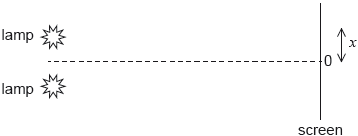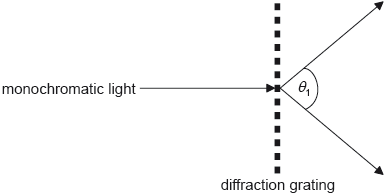| Date | May 2017 | Marks available | 2 | Reference code | 17M.2.HL.TZ2.4 |
| Level | Higher level | Paper | Paper 2 | Time zone | 2 |
| Command term | Suggest | Question number | 4 | Adapted from | N/A |
Question
A student investigates how light can be used to measure the speed of a toy train.
Light from a laser is incident on a double slit. The light from the slits is detected by a light sensor attached to the train.
The graph shows the variation with time of the output voltage from the light sensor as the train moves parallel to the slits. The output voltage is proportional to the intensity of light incident on the sensor.
As the train continues to move, the first diffraction minimum is observed when the light sensor is at a distance of 0.13 m from the centre of the fringe pattern.
A student investigates how light can be used to measure the speed of a toy train.
Light from a laser is incident on a double slit. The light from the slits is detected by a light sensor attached to the train.
The graph shows the variation with time of the output voltage from the light sensor as the train moves parallel to the slits. The output voltage is proportional to the intensity of light incident on the sensor.
Explain, with reference to the light passing through the slits, why a series of voltage peaks occurs.
The slits are separated by 1.5 mm and the laser light has a wavelength of 6.3 x 10–7 m. The slits are 5.0 m from the train track. Calculate the separation between two adjacent positions of the train when the output voltage is at a maximum.
Estimate the speed of the train.
Determine the width of one of the slits.
Suggest the variation in the output voltage from the light sensor that will be observed as the train moves beyond the first diffraction minimum.
In another experiment the student replaces the light sensor with a sound sensor. The train travels away from a loudspeaker that is emitting sound waves of constant amplitude and frequency towards a reflecting barrier.
The graph shows the variation with time of the output voltage from the sounds sensor.
Explain how this effect arises.
Markscheme
«light» superposes/interferes
pattern consists of «intensity» maxima and minima
OR
consisting of constructive and destructive «interference»
voltage peaks correspond to interference maxima
«» 2.1 x 10–3 «m»
If no unit assume m.
Correct answer only.
correct read-off from graph of 25 m s
v = «» 8.4 x 10–2 «m s–1»
Allow ECF from (b)(i)
angular width of diffraction minimum = «= 0.026 rad»
slit width = «» 2.4 x 10–5 «m»
Award [1 max] for solution using 1.22 factor.
«beyond the first diffraction minimum» average voltage is smaller
«voltage minimum» spacing is «approximately» same
OR
rate of variation of voltage is unchanged
OWTTE
«reflection at barrier» leads to two waves travelling in opposite directions
mention of formation of standing wave
maximum corresponds to antinode/maximum displacement «of air molecules»
OR
complete cancellation at node position




